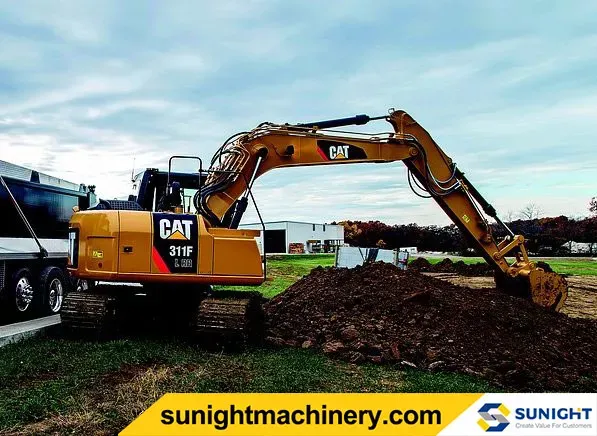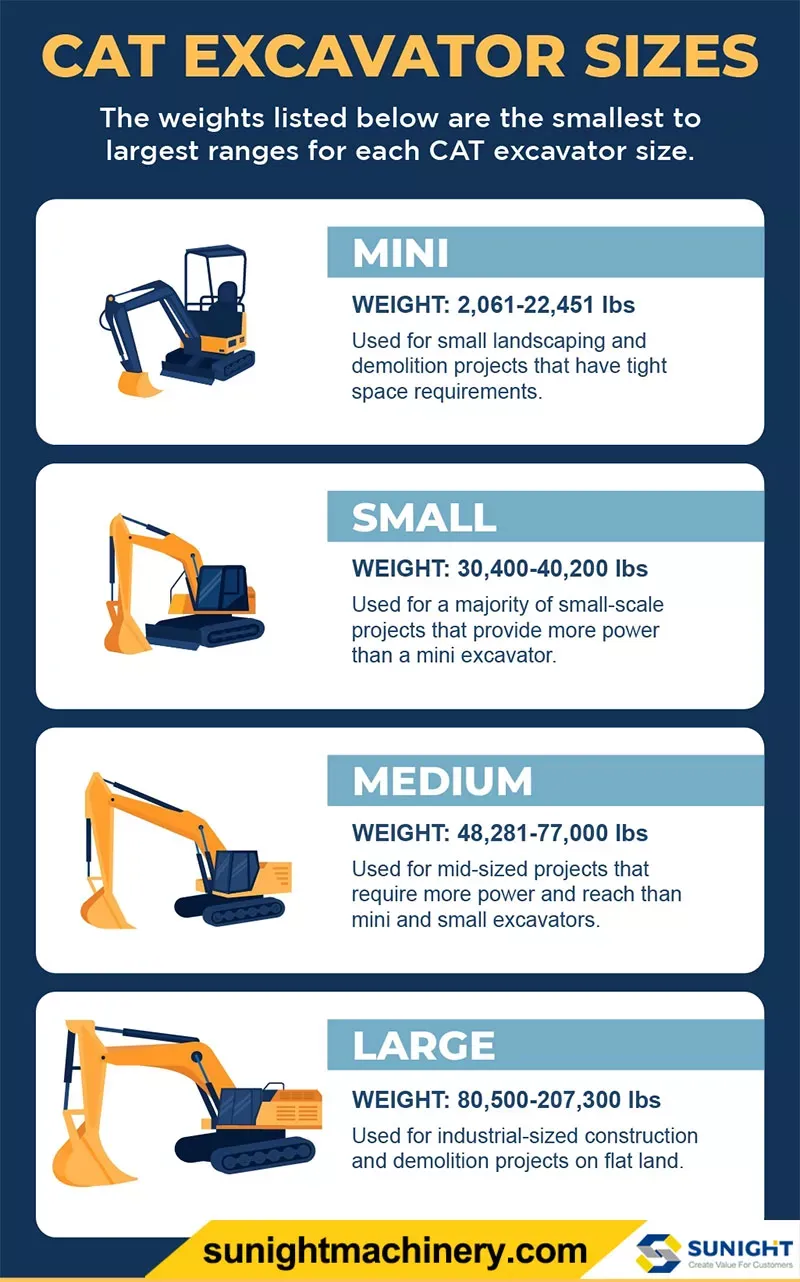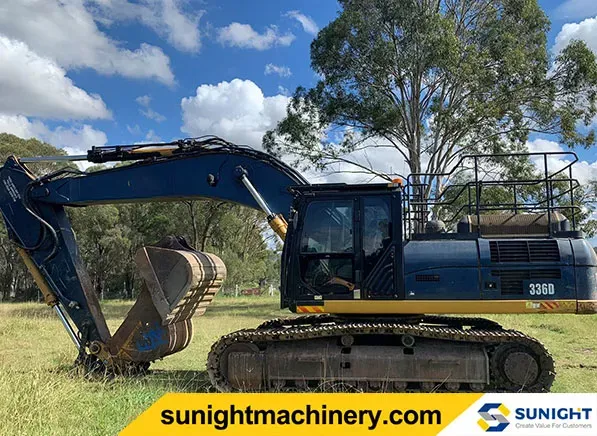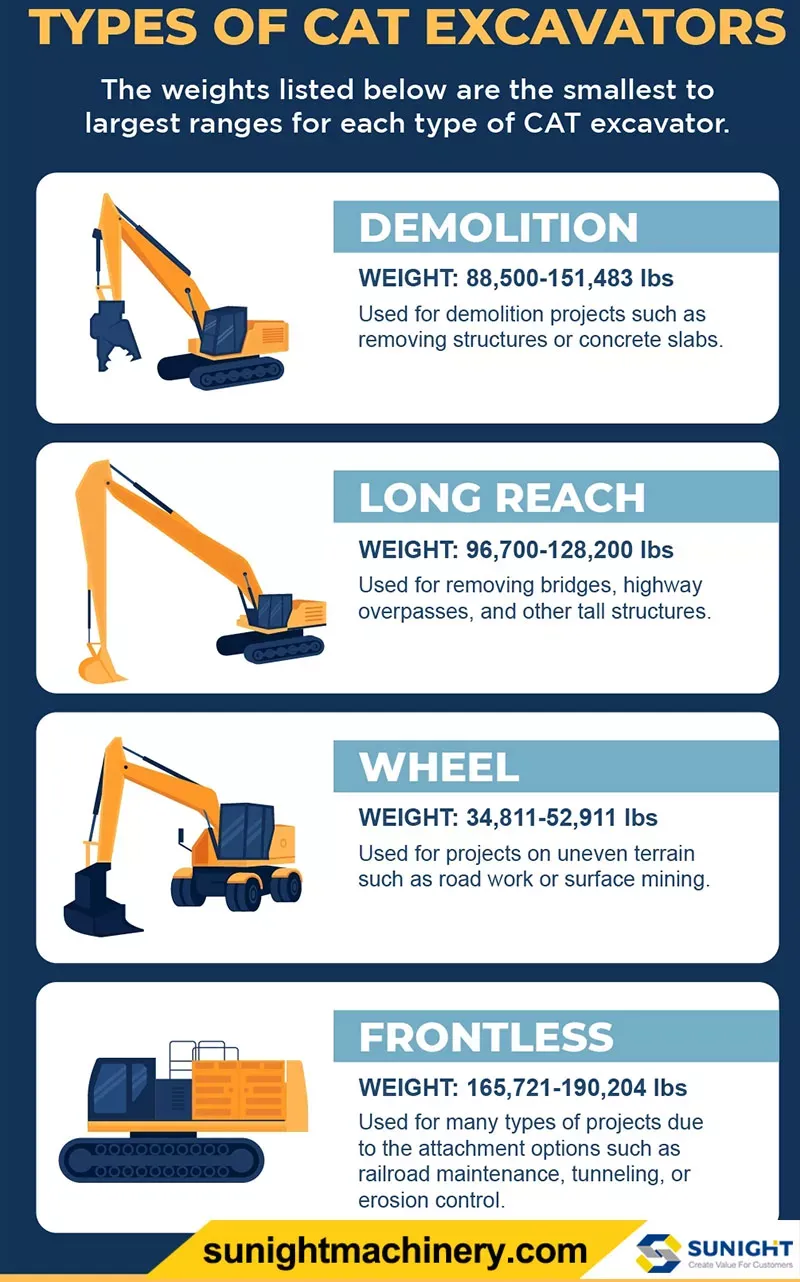
Shanghai Sunight Machinery Co., Ltd. is a leading Chinese construction machinery exporter, located in the downtown of Shanghai City.
CAT Excavator Size Guide
Caterpillar, commonly known as CAT, has been around since 1925 and is the world’s largest manufacturer of construction and mining equipment. CAT manufactures a wide variety of heavy equipment for virtually any job site. Caterpillar excavators provide both durability and versatility. They are worth considering for landscaping, construction, trenching, and a host of other heavy-duty tasks.

Some moderate or smaller jobs may be better suited to a backhoe, which offers more mobility and can be driven on roads to get from one work site to another. Both are easy to rent once you decide whether you need an excavator or a backhoe.
Excavator Sizes
Caterpillar offers four sizes and four types of excavators. You will want to consider the size of your job, the configuration of your job site, the amount of horsepower you need, and how deep you need to dig, among other factors, when deciding which one to choose.

Mini Excavators (2,061-22,451 lbs)
Caterpillar offers nearly two dozen CAT mini excavators that range in size from 1 to 10 metric tons and come in standard or compact radius (CR mini) models. The smallest models offer 13 horsepower engines and a digging depth of more than 5½ feet. The biggest engine mini hydraulic excavators can give you nearly 70 hp of net power and the ability to dig nearly three times as far: more than 15 feet. Mini excavators are an excellent choice when working in cramped spaces or on crowded job sites such as parking lots and indoors. With reduced or zero tail-swing, they’re easier to navigate around obstacles and in tight quarters.

Cat Mini Excavators (1-10 tons)
The smallest of the four, the mini excavator range consists of excavators ranging from 1t to 10t. In fact, the smallest Caterpillar excavator available, currently, is the 300.9D weighing in at just 935 kg. It’s a tiny workhorse with a punchy Yanmar engine putting out a net 13HP.
And yet the largest of the mini range, the 310, weighs in at 10,182 kg (9,601 with no counterweight or bucket) and the Cat C3.3B engine brings a net 70.3HP to your worksite. So Caterpillar really gives you a wide variety of choice in their mini excavator range.
Excavators in the mini range are great for tighter work spaces or for smaller tasks that don’t need heavy or overly powerful machines. Mini excavators are also a great option for those tight-access areas. Being a compact size, these excavators are easier to transport and get onto the worksite.
Small Excavators (30,400-40,200 lbs)
Small CAT excavators are designed for fuel efficiency to reduce operating costs and emissions. They can be equipped with a variety of attachments for different kinds of jobs. Caterpillar excavator attachments include hammers, shears, demolition and sorting grapples, compactors, pulverizers, couplers, and thumbs.

Small excavator engine models start where minis leave off, with the smallest providing 73 hp of power, ranging up to the largest at 130 hp. Their hydraulic systems allow you to dig deeper than a compact excavator can, as well: between 19.6 and 21 feet, depending on the model you choose.
The CAT 315, for instance, can dig 19.6 feet and dig, swing, and dump within a working space of under 13 feet. Auxiliary hydraulic options can accommodate a wide variety of attachments, and the engine meets EPA Tier 4 Final emission standards.
Cat Small Excavators (11-18 tons)
Moving up from the mini excavator range, we’re going to take a look at Caterpillar’s range of small excavators. Weighing from 11t to 18t, these machines bring the focus back from getting into the smallest possible space, to bringing a good balance of power for a reduced size and weight.
Currently the smallest excavator in this range is the 311F L RR, weighing in at 13t and packing 70HP, it is touted by Caterpillar as the machine you’re looking for if “you want a machine with the power to match your jobs but owning and operating costs to fit your business.”
Or, if you need a larger operating weight and a more powerful engine, then the 318F L may be what you’re after. It’s the largest of the small excavators Cat has on offer and features a C4.4 ACERT engine with 117HP net power.
Like the medium and large Cat excavator sizes, the small range comes with CAT Connect technology and compatibility with a selection of Cat attachments.
Cat’s small excavators boast increased versatility, power and flexibility when compared to the mini excavator range. They are suited for much of the same work that the mini range is, as well as larger and more varied tasks.
Medium Excavators (48,281-77,000 lbs)
Medium excavators allow you to dig deeper — up to nearly 24 feet with some models — supplying significantly more power than small excavators can provide, with up to 273 hp. Their operating weight is heavier, too: up to 77,000 pounds for the largest, compared with half that for the heaviest small excavator.

Like other excavators, these can be equipped with a variety of work tools: attachments that allow you to perform a variety of tasks, from digging to loading to compacting. Jobs well-suited for a medium excavator include sloping, leveling, fine grading, and trenching. They can also be used for demolition projects, drilling shafts, and fairly large-scale industrial projects.
Cat Medium Excavators (20-35 tons)
Moving up another bracket, we hit the medium excavator range. Weighing in at 20t to 35t, these excavators are where the real power really kicks in. Featuring patented Cat technology and compatible with a huge variety of attachments, Cat’s medium excavators showcase the best of what the company has to offer.
The baby of the range, the Cat 320, has an operating weight of 22,500 kg, while the Cat C4.4 ACERT engine provides 162 HP of net power. Of course, that’s just the start, the 320 has a few variants, including the 320D, 320DL and the 320DRR.
While the biggest of the medium range is the 335F L. It has a maximum operating weight of 38,180 kg, and a minimum of 34,330 kg (which is why it’s in the medium category).
Medium excavators bring more power than the mini or small excavator range. And, in some cases, may provide a more affordable alternative for larger projects than a large excavator, as they are generally cheaper and easier to transport than the large range.
Large Excavators (80,500-207,300 lbs)
Large excavators can weigh as much as 207,300 pounds (103.5 tons) and pack horsepower ranging from 273 to 542. If you’re planning excavations and have room to accommodate these machines, they can be a valuable asset, with a capacity to dig 27 feet to nearly 32 feet down.
These excavators are crawlers, running on tracks rather than wheels. The largest new CAT in this class, the 395, is a next-generation model that’s up to 10% more productive than its predecessor, the 395F. It comes equipped with USB ports and Bluetooth technology, as well as advanced viscous mounts that reduce cab vibration by as much as 50% compared with earlier models.

Large excavators can be used for grading hilly areas, mining, and lifting heavy debris and soil. Because of their size, they need plenty of room to operate and are best suited to outdoor jobs on open worksites.
Cat Large Excavators (36-90 tons)
While they may be the heaviest, excavators of the lot, Caterpillar’s large excavator range brings more than enough power to make up for it. Ranging from 36t to 90t, this is the largest range for weight and HP. It has the biggest difference between the smallest and largest model (though it has the least selection of models available).
Weighing in at 37,200 kg, the 336 is the smallest of the large excavators, though you can get the 336 GC, which is a lighter version of the 336, weighing in at 33,900 kg. And, while you may think 33-37t isn’t light, the 390F L dwarfs the 336.
The 390F L has an operating weight of 86,840 KG, a Cat C18 ACERT engine packing 543 HP, and a 12,230 mm reach at ground level.
Like the small and medium range, large excavators come with exclusive Cat Connect technology and are compatible with a variety of Cat attachments.
Due to their size, power and fuel-efficiency, large excavators are ideal for large, bulky earthmoving and heavy lifting. While they may not be able to fit into tight spaces, they bring unrivalled power that the smaller models simply can’t match.
Excavator Types
In addition to deciding how big your excavator needs to be, you’ll also want to choose the right type for the job you’re about to undertake. CAT offers four types of excavators specifically designed for different tasks: demolition, long reach, wheel, and frontless excavators.

Demolition Excavators (88,500-151,483 lbs)
Demolition excavators are designed to help you raze structures on a site. CAT offers three types with different reaches. The 340 Straight Boom is good for demolition and excavation projects at ground level. It’s a relatively lightweight (for its class) machine that provides 314 horsepower.
If you need to demolish tall structures, the 340 UHD and 352 UHD are heavier machines with better reach. The 340 UHD can extend up to eight stories high. The 532 UHD is a heavier machine at 75.7 tons with greater horsepower (425) that can reach up to nine stories high.
Long Reach Excavators (96,700-128,200 lbs)
Long reach excavators can dig at target areas far away from the cab and can go much deeper than other excavators: nearly 43 feet.
CAT offers two models. The lighter 311 hp 340 Long Reach can hit targets up to 60 feet away. The heavier 352 LRE provides added counterweight for long-reach digging. Both are good choices for getting at hard-to-reach dig sites and can be used for projects like breaking down walls that are over bodies of water.
Wheel Excavators (34,811-52,911 lbs)
CAT’s wheel excavator line includes 11 models that run on wheels rather than tracks. Ranging in size from 36,400 to 46,407 pounds, different models can dig to a variety of depths, with horsepower ratings of 134 to 174.
Their wheels make them easier to maneuver but not as well suited to rough terrain as track excavators, or crawlers. Wheel excavators also have a tighter turning radius, making them ideal for small job sites and road construction.
Frontless Excavators (165,721-190,204 lbs)
CAT’s line includes two frontless excavators: the smaller 374F OEM at 472 hp and 165,721 pounds, and the larger 390F OEM at 190,204 pounds.
Frontless excavators can be used for a variety of jobs including railroad maintenance and dredging.
How To Pick the Right Excavator for the Job
There are eight different types of excavators from which to choose, with your selection depending on the size and nature of your job and worksite.
The smallest CAT excavator, at just 13 hp and 2,061 pounds, can dig to a depth of less than six feet. It’s compact to fit in tight spaces and can even be used indoors. The largest, the 395, provides more than 41 times as much horsepower as the smallest mini and can dig 32 feet deep.
Long-reach excavators can go even deeper, and demolition excavators are perfect for knocking down structures to clear the way for new construction.
Previous : Using Hydraulic Excavators in the Construction IndustryNext : Uses of Mini Excavator for Landscaping Applications
喜欢我的文章吗?
别忘了给点支持与赞赏,让我知道创作的路上有你陪伴。
发布评论…